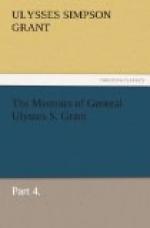The Army of the Ohio had been getting supplies over Cumberland Gap until their animals had nearly all starved. I now determined to go myself to see if there was any possible chance of using that route in the spring, and if not to abandon it. Accordingly I left Nashville in the latter part of December by rail for Chattanooga. From Chattanooga I took one of the little steamers previously spoken of as having been built there, and, putting my horses aboard, went up to the junction of the Clinch with the Tennessee. From that point the railroad had been repaired up to Knoxville and out east to Strawberry Plains. I went by rail therefore to Knoxville, where I remained for several days. General John G. Foster was then commanding the Department of the Ohio. It was an intensely cold winter, the thermometer being down as low as zero every morning for more than a week while I was at Knoxville and on my way from there on horseback to Lexington, Kentucky, the first point where I could reach rail to carry me back to my headquarters at Nashville.
The road over Cumberland Gap, and back of it, was strewn with debris of broken wagons and dead animals, much as I had found it on my first trip to Chattanooga over Waldron’s Ridge. The road had been cut up to as great a depth as clay could be by mules and wagons, and in that condition frozen; so that the ride of six days from Strawberry Plains to Lexington over these holes and knobs in the road was a very cheerless one, and very disagreeable.
I found a great many people at home along that route, both in Tennessee and Kentucky, and, almost universally, intensely loyal. They would collect in little places where we would stop of evenings, to see me, generally hearing of my approach before we arrived. The people naturally expected to see the commanding general the oldest person in the party. I was then forty-one years of age, while my medical director was gray-haired and probably twelve or more years my senior. The crowds would generally swarm around him, and thus give me an opportunity of quietly dismounting and getting into the house. It also gave me an opportunity of hearing passing remarks from one spectator to another about their general. Those remarks were apt to be more complimentary to the cause than to the appearance of the supposed general, owing to his being muffled up, and also owing to the travel-worn condition we were all in after a hard day’s ride. I was back in Nashville by the 13th of January, 1864.
When I started on this trip it was necessary for me to have some person along who could turn dispatches into cipher, and who could also read the cipher dispatches which I was liable to receive daily and almost hourly. Under the rules of the War Department at that time, Mr. Stanton had taken entire control of the matter of regulating the telegraph and determining how it should be used, and of saying who, and who alone, should have the ciphers. The operators possessed of the ciphers, as well as the ciphers used, were practically independent of the commanders whom they were serving immediately under, and had to report to the War Department through General Stager all the dispatches which they received or forwarded.




